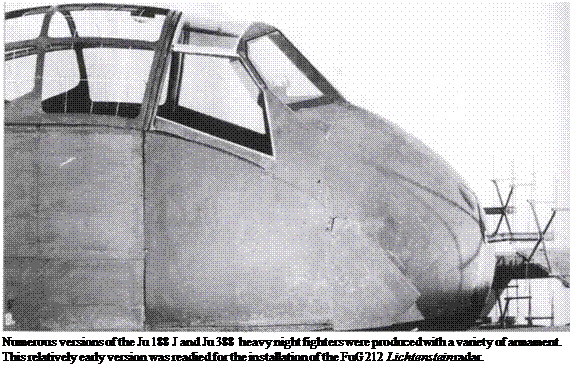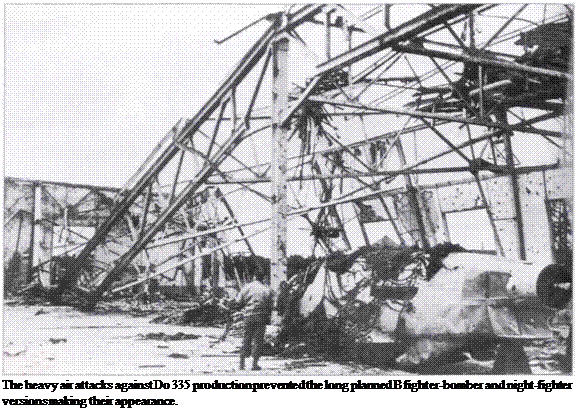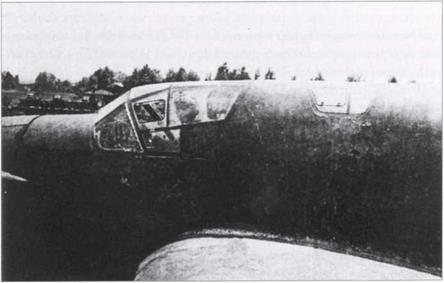High-Performance Night Fighters
To the very end, OKL believed that the introduction of faster fighters would give the night-fighter arm its old sparkle. From 1944, the possibilities open to the German aviation industry were increasingly limited. The Luftwaffe had held back and relied too long on the old machines, particularly the Ju 88 G-6 or He 219 A. From the outbreak of war, too little emphasis, or rejection on ideological grounds, had impeded the development of superchargers for altitude

work and other futuristic ideas. What remained ultimately was tinkering with existing aircraft in the hope of improving them. The development of night – fighter versions such as the Ju 388 J-l to J-3 did not receive the necessary support from the Jagerstab and later the Rustungsstab.
The principal obstacle was the shortage of high-performance engines, particularly the Jumo 222 E-l or F-l. For a time the Jumo 213 E-l was tried in the hope of turning the He 219 A-2 or Ju 88 G-6 into a superior night fighter, the equal of the RAF Mosquito. The problem was that changes to the fuselage had a limit. The first nine four-seater Ju 88 G-7s were basically a Ju 88 G-6 with two Jumo 213 E-l engines for altitude performance. The aircraft had a G-6 fuselage, a Ju 188 E-l tailplane and unmodified Ju 88 A-4 wings and undercarriage. Only a few of these machines were produced between November 1944 and March 1945. The first two (Ju 88 V-112 and V-113) remained unserviceable until 7 March 1945 because of engine problems. A single Ju 88 G-7 joined the OKL experimental unit on 29 March 1945.
Another white hope for the Luftwaffe night fighter arm was Ju 388 J-l, a hybrid of PE+IA and Ju 388 V-2 (РЕФІВ) which could have been an outstanding night fighter with an FuG 240 radar and powerful engines. The entire
Ju 388 development and the production of new aircraft were cancelled at the beginning of 1945, however. A number ofju 388 J-l aircraft were left at Mockau near Leipzig. It seems that this machine, though expensive to turn out, would have been without doubt a high-performance night fighter.
The He 219, especially the A-7 series, seemed another good prospect as a high-performance aircraft towards the end of 1944, and the Main Development Commission considered it to be the Luftwaffe’s best, but the six experimental machines equipped with Jumo 213 В engines were too few to confront RAF Mosquitos on a substantial basis. The 21 He 219 A-7s delivered between February and the beginning of April 1945 went into the OKL reserve for lack of fuel. The series was still being built at Heinkel Vienna (Heidfeld) until the end of the war, and a few definitely got through to NJG 1 for testing under operational conditions.
The Focke-WulfTa 154 could have been produced in wood. The night-fighter version appeared only in ones and twos, under-powered with Jumo 213 A-l engines. In November 1944, Gruppenstab III./NJG 3 at Stade carried out some half-hearted operational tests. Up to 16 March 1945 there were a few sorties against RAF Mosquitos but nothing came of them. Most aircraft were left at the airfield boundary for later enemy aerial target practice. High-performance engines such as the turbo-charged Jumo 213 E-l could have been made available for the Та 154 A-2 but Oberst Radusch was not interested in the machine, and tests were abandoned for lack of fuel.
|
One of the few Do 335 night fighters. The aircraft was finally completed by German technicians – under French supervision – postwar and flight-tested. |

The auxiliary night-fighter versions of the Do 335 were the A-5 single seater and A-6 two-seater of which great things were expected. The first high – performance night fighter Do 335 В-6 was due to roll off the production lines at Heinkel Oranienburg and Lothar-Jordan, Braunschweig, at the beginning of 1945, but mass production was halted for lack of materials, and by the war’s end only a few were being built at Dornier Oberpfaffenhofen. On 26 January 1945, Saur advised industry that the Do 335 night fighter could only be built as an experimental aircraft for study purposes. The first, Do 335 М-10 (СРФ1Ж) was airworthy at the beginning of 1945 and tested at Diepensee and Oranienburg. It was captured by the Russians in a damaged condition at the end of April 1945.
Other, mostly Focke-Wulf designed, high-performance night fighters with piston engines and auxiliary turbines remained in the project stage and were not built even for experimental purposes.











